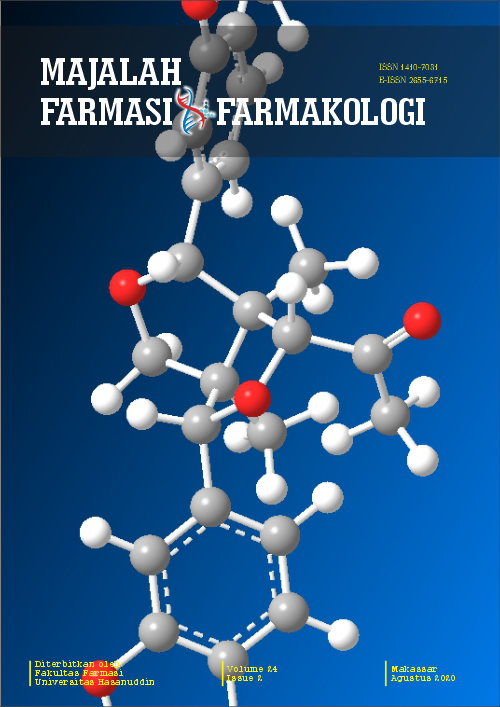AKTIVITAS ANTIOKSIDAN FRAKSI DARI DAUN Garcinia kydia Roxburgh
Abstract
Garcinia kydia Roxburgh merupakan salah satu spesies dari genus garcinia, yang secara khusus belum banyak diketahui aktivitas senyawa bioaktif, namun pada penelitian sebelumnya terbukti berpotensi sebagai agen penghambat α-glukosidase. Pada penelitian ini, akan dilakukan investigasi aktivitas antioksidan terhadap berbagai fraksi yang diperoleh dari daun G. kydia Roxb. Metode penelitian dilakukan dengan menentukan aktivitas antioksidan melalui analisis in-vitro menggunakan microplete reader dengan metode radical scavenging (Metode DPPH) dan ferric reducing antioxidant power (Metode FRAP). Hasil menunjukkan bahwa fraksi yang paling aktif dari ekstrak etil asetat adalah FEA8 (DPPH) dan FEA7 (FRAP), sedangkan fraksi paling aktif dari ekstrak metanol adalah FMT4 (DPPH) dan FMT6 (FRAP). Aktivitas antioksidan tertinggi di antara empat fraksi adalah FEA7 dan FEA8. Aktivitas fraksi FEA7 dan FEA8 ditentukan oleh nilai EC50, sehingga diperoleh masing-masing 9,73 dan 9,26 μg/mL (DPPH); 10,28 dan 13,94 μg/mL (FRAP). Garcinia kydia Roxb. berpotensi sebagai agen antioksidan dengan mekanisme yang berbeda. Sehingga hasil penelitian terkait terdapatnya potensi antioksidan tersebut dapat memberikan alternatif terapi diabetes yang disertai komplikasi stres oksidatif.
References
Gontijo VS, De Souza TC, Rosa IA, Soares MG, Da Silva MA, Vilegas W, et al. Isolation and evaluation of the antioxidant activity of phenolic constituents of the Garcinia brasiliensis epicarp. Food Chem [Internet]. 2012;132(3):1230–1235. Available from: http://dx.doi.org/10.1016/j.foodchem.2011.10.110
Hemshekhar M, Sunitha K, Santhosh MS, Devaraja S, Kemparaju K, Vishwanath BS, et al. An overview on genus garcinia: Phytochemical and therapeutical aspects. Phytochem Rev. 2011;10(3):325–351.
Fouotsa H, Lannang AM, Mbazoa CD, Rasheed S, Marasini BP, Ali Z, et al. Xanthones inhibitors of α-glucosidase and glycation from Garcinia nobilis. Phytochem Lett. 2012;5(2):236–239.
Mahamodo S, Rivière C, Neut C, Abedini A, Ranarivelo H, Duhal N, et al. Antimicrobial prenylated benzoylphloroglucinol derivatives and xanthones from the leaves of Garcinia goudotiana. Phytochemistry [Internet]. 2014;102:162–168. Available from: http://dx.doi.org/10.1016/j.phytochem.2014.03.006
Wu YP, Zhao W, Xia ZY, Kong GH, Lu XP, Hu QF, et al. Three new xanthones from the stems of Garcinia oligantha and their anti-TMV activity. Phytochem Lett [Internet]. 2013;6(4):629–632. Available from: http://dx.doi.org/10.1016/j.phytol.2013.08.006
Supasuteekul C, Nonthitipong W, Tadtong S, Likhitwitayawuid K, Tengamnuay P, Sritularak B. Antioxidant, DNA damage protective, neuroprotective, and α-glucosidase inhibitory activities of a flavonoid glycoside from leaves of Garcinia gracilis. Brazilian J Pharmacogn [Internet]. 2016;26(3):312–320. Available from: http://dx.doi.org/10.1016/j.bjp.2016.01.007
Mohamed GA, Al-Abd AM, El-halawany AM, Abdallah HM, Ibrahim SRM. New xanthones and cytotoxic constituents from Garcinia mangostana fruit hulls against human hepatocellular, breast, and colorectal cancer cell lines. J Ethnopharmacol [Internet]. 2017;198:302–312. Available from: http://dx.doi.org/10.1016/j.jep.2017.01.030
Parveen M, Azaz S, Zafar A, Ahmad F, Silva MR, Silva PSP. Structure elucidation, DNA binding specificity and antiproliferative proficiency of isolated compounds from Garcinia nervosa. J Photochem Photobiol B Biol [Internet]. 2017;167:176–188. Available from: http://dx.doi.org/10.1016/j.jphotobiol.2016.12.035
Wahyuni FS, Ali DAI, Lajis NH, Dachriyanus. Anti-inflammatory activity of isolated compounds from the Stem Bark of Garcinia cowa Roxb. Pharmacogn J. 2017;9(1):55–57.
Dontha S. A review on antioxidant methods. Asian J Pharm Clin Res. 2016;9(2):14–32.
Muriithi E, Bojase-Moleta G, Majinda RRT. Benzophenone derivatives from Garcinia livingstonei and their antioxidant activities. Phytochem Lett [Internet]. 2016;18:29–34. Available from: http://dx.doi.org/10.1016/j.phytol.2016.08.019
Tian DS, Gu W, Wang LP, Huang LJ, Rao Q, Huang T, et al. Cytotoxic and anti-oxidant biphenyl derivatives from the leaves and twigs of Garcinia multiflora. Phytochem Lett [Internet]. 2017;19:132–135. Available from: http://dx.doi.org/10.1016/j.phytol.2016.12.021
Carrillo-Hormaza L, Ramírez AM, Quintero-Ortiz C, Cossio M, Medina S, Ferreres F, et al. Comprehensive characterization and antioxidant activities of the main biflavonoids of Garcinia madruno: A novel tropical species for developing functional products. J Funct Foods [Internet]. 2016;27:503–516. Available from: http://dx.doi.org/10.1016/j.jff.2016.10.001
Taher M, Susanti D, Rezali MF, Zohri FSA, Ichwan SJA, Alkhamaiseh SI, et al. Apoptosis, antimicrobial and antioxidant activities of phytochemicals from Garcinia malaccensis Hk.f. Asian Pac J Trop Med [Internet]. 2012;5(2):136–141. Available from: http://dx.doi.org/10.1016/S1995-7645(12)60012-1
Biloa Messi B, Ho R, Meli Lannang A, Cressend D, Perron K, Nkengfack AE, et al. Isolation and biological activity of compounds from Garcinia preussii. Pharm Biol. 2014;52(6):706–711.
Putri NL, Elya B, Puspitasari N. Antioxidant activity and lipoxygenase inhibition test with total flavonoid content from Garcinia kydia roxburgh leaves extract. Pharmacogn J. 2017;9(2):280–284.
Elya B, Katrin, Mun’im A, Hasiholan A, Marlin I, Mailandari M. Antioxidant activities of leaves extracts of three species of Garcinia. Int J Med Arom Plants. 2012;2(4):691–693.
Martha S, Elya B, Hanafi M. Comparison of inhibitory activity against the α-glucosidase enzymes in the extracts and fractions from leaves of the Garcinia kydia Roxburgh. Asian J Pharm Clin Res. 2017;10(7):401–404.
Sanseera D, Liawruangrath B, Pyne SG, Liawruangrath S. Determination of antioxidant and anticancer activities together with total phenol and flavonoid contents of Cleidion javanicum Bl. And Bridelia retusa (L.) A. Juss. Chiang Mai J Sci. 2016;43(3):534–545.
Jiangseubchatveera N, Liawruangrath S, Teerawutgulrag A, Santiarworn D, Pyne SG, Liawruangrath B. Phytochemical screening, phenolic and flavonoid contents, antioxidant and cytotoxic activities of Graptophyllum pictum (L.) Griff. Chiang Mai J Sci. 2017;44(1):193–202.
Juma I. Assessment of antioxidant potentials of the wild and domesticated saprophytic edible mushrooms from Tanzania. Curr Res Environ Appl Mycol. 2016;6(1):1–10.
Nyau V, Prakash S, Rodrigues J, Farrant J. Antioxidant activities of Bambara groundnuts as assessed by FRAP and DPPH assays. Am J Food Nutr [Internet]. 2015;3(1):7–11. Available from: http://pubs.sciepub.com/ajfn/3/1/2/index.html
Maizura M, Aminah A, Aida WMW. Total phenolic content and antioxidant activity of kesum (Polygonum minus), ginger (Zingiber officinale) and turmeric (Curcuma longa) extract. Int Food Res J. 2011;18(2).
Sousa A, Araújo P, Azevedo J, Cruz L, Fernandes I, Mateus N, et al. Antioxidant and antiproliferative properties of 3-deoxyanthocyanidins. Food Chem. 2016;192:142–148.
Pereira ACH, Lenz D, Nogueira BV, Scherer R, Andrade TU, Da Costa HB, et al. Gastroprotective activity of the resin from Virola oleifera. Pharm Biol [Internet]. 2017;55(1):472–480. Available from: http://dx.doi.org/10.1080/13880209.2016.1251467
Chen Z, Bertin R, Froldi G. EC50 estimation of antioxidant activity in DPPH* assay using several statistical programs. Food Chem [Internet]. 2013;138(1):414–420. Available from: http://dx.doi.org/10.1016/j.foodchem.2012.11.001
Maesaroh K, Kurnia D, Al Anshori J. Perbandingan Metode Uji Aktivitas Antioksidan DPPH, FRAP dan FIC Terhadap Asam Askorbat, Asam Galat dan Kuersetin. Chim Nat Acta. 2018;6(2):93.
Alam MN, Bristi NJ, Rafiquzzaman M. Review on in vivo and in vitro methods evaluation of antioxidant activity. Saudi Pharm J [Internet]. 2013;21(2):143–152. Available from: http://dx.doi.org/10.1016/j.jsps.2012.05.002
Molyneux P. The use of the stable free radical diphenylpicryl-hydrazyl (DPPH) for estimating anti-oxidant activity. Songklanakarin J Sci Technol. 2004;26(2):211–219.
Blois MS. Antioxidant determinations by the use of a stable free radical. Nature. 1958;181:1199–1200.
Kumar S, Pandey AK. Review Article Chemistry and Biological Activities of Flavonoids: An Overview. Sci World J. 2013;
Ozgen S, Kilinc OK, Selamoglu Z. Antioxidant Activity of Quercetin: A Mechanistic Review. Turkish J Agric -Food Sci Technol [Internet]. 2016;4(412):1134–1138. Available from: www.agrifoodscience.com,
Csepregi K, Neugart S, Schreiner M, Hideg É. Comparative evaluation of total antioxidant capacities of plant polyphenols. Molecules. 2016;21(2):1–17.
Downloads
Published
Issue
Section
License
The copyright to this article is transferred to Universitas Hasanuddin (UNHAS) if and when the article is accepted for publication. The undersigned hereby transfers all rights in and to the paper including without limitation all copyrights to UNHAS. The undersigned hereby represents and warrants that the paper is original and that he/she is the author of the paper, except for material that is clearly identified as to its original source, with permission notices from the copyright owners where required. The undersigned represents that he/she has the power and authority to make and execute this assignment.
We declare that:
- This paper has not been published in the same form elsewhere.
- It will not be submitted anywhere else for publication prior to acceptance/rejection by this Journal.
- A copyright permission is obtained for materials published elsewhere and which require this permission for reproduction.
Furthermore, I/We hereby transfer the unlimited rights of publication of the above-mentioned paper in whole to UNHAS The copyright transfer covers the exclusive right to reproduce and distribute the article, including reprints, translations, photographic reproductions, microform, electronic form (offline, online) or any other reproductions of similar nature.
The corresponding author signs for and accepts responsibility for releasing this material on behalf of any and all co-authors. This agreement is to be signed by at least one of the authors who have obtained the assent of the co-author(s) where applicable. After submission of this agreement signed by the corresponding author, changes of authorship or in the order of the authors listed will not be accepted.


